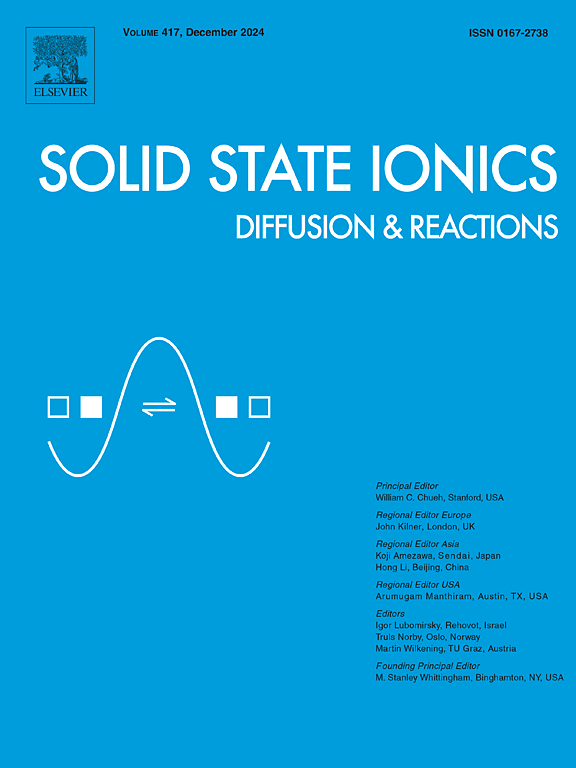基于i-卡拉胶掺杂NH4HCO2固体电解质的电化学电池的制备
IF 3
4区 材料科学
Q3 CHEMISTRY, PHYSICAL
引用次数: 0
摘要
采用溶液铸造法,在不同浓度的NH4HCO2条件下制备了一种基于iota卡拉胶(iCG)的天然聚合物电解质(NPE)。选用蒸馏水作为溶剂。对iCG: NH4HCO2体系的结构、热、电和电化学分析证实了其非晶性、低玻璃化转变温度(Tg = 48°C)、最大直流电导率和电化学稳定性(3.11 V)。在1 g iCG: 0.4 wt% NH4HCO2体系中,最大直流电导率为1.94 × 10−3 S cm−1。以MnO2为正极,Zn/ZnSO4·7H2O为阳极为正极,构建了一次质子电池(PPB),并对1 g iCG: 0.4 wt% NH4HCO2 NPE的效率进行了评价。此外,用1g iCG: 0.4 wt% NH4HCO2 NPE制备了单个PEMFC。PPB和PEM燃料电池的OCV分别为1.60 V和616 mV。本文章由计算机程序翻译,如有差异,请以英文原文为准。

Fabrication of electrochemical cell based on i-carrageenan doped NH4HCO2 solid electrolyte
Solution casting method was used to develop a natural polymer electrolyte (NPE) based on iota carrageenan (iCG) using different amounts of NH4HCO2. Distilled Water was chosen as the solvent. The structural, thermal, electrical, and electrochemical analyses of the iCG: NH4HCO2 system confirmed its non-crystalline nature, low glass transition temperature (Tg = 48 °C), maximum DC conductivity and electrochemical stability (3.11 V). The maximum DC conductivity for the composition 1 g iCG: 0.4 wt% NH4HCO2 was observed to be 1.94 × 10−3 S cm−1. A primary proton battery (PPB) was constructed by sandwiching the optimum electrolyte between MnO2 as the cathode and Zn/ZnSO4·7H2O as the anode to evaluate the efficiency of the 1 g iCG: 0.4 wt% NH4HCO2 NPE. Additionally, a single PEMFC was fabricated with 1 g iCG: 0.4 wt% NH4HCO2 NPE. An OCV for PPB and PEM fuel cell were found to be 1.60 V and 616 mV, respectively.
求助全文
通过发布文献求助,成功后即可免费获取论文全文。
去求助
来源期刊

Solid State Ionics
物理-物理:凝聚态物理
CiteScore
6.10
自引率
3.10%
发文量
152
审稿时长
58 days
期刊介绍:
This interdisciplinary journal is devoted to the physics, chemistry and materials science of diffusion, mass transport, and reactivity of solids. The major part of each issue is devoted to articles on:
(i) physics and chemistry of defects in solids;
(ii) reactions in and on solids, e.g. intercalation, corrosion, oxidation, sintering;
(iii) ion transport measurements, mechanisms and theory;
(iv) solid state electrochemistry;
(v) ionically-electronically mixed conducting solids.
Related technological applications are also included, provided their characteristics are interpreted in terms of the basic solid state properties.
Review papers and relevant symposium proceedings are welcome.
 求助内容:
求助内容: 应助结果提醒方式:
应助结果提醒方式:


